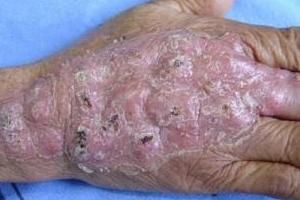
- Clinical Technology
- Adult Immunization
- Hepatology
- Pediatric Immunization
- Screening
- Psychiatry
- Allergy
- Women's Health
- Cardiology
- Pediatrics
- Dermatology
- Endocrinology
- Pain Management
- Gastroenterology
- Infectious Disease
- Obesity Medicine
- Rheumatology
- Nephrology
- Neurology
- Pulmonology
What Culprit Hidden in This Gardener's Back Yard Caused These Deep, Scaly Nodules?

A 58-year-old gardener suffered many deep scratches while tending to his backyard rose bushes. Several weeks later, he developed multiple, indurated, slightly scaly, deep dermal to subcutaneous nodules on the hand. He also noted gradual tender swelling in the ipsilateral axilla. Overall review of systems was benign, as was the past medical and family history. The patient was not taking any medications. His wife and a young adult child still living at home were free of similar findings.
Which of the following interventions is considered the treatment of choice for this patient’s condition?
A. Oral griseofulvin
B. Cryosurgery
C. Oral ketoconaozle
D. Oral itraconaozle
E. Intravenous amphotericin B
Answer: D-Oral itraconazole
Discussion
This patient’s history is classic for sporotrichosis caused by the fungus Sporothrix schenkii. This organism is found in the soil almost worldwide, although it is considered endemic to Mexico, Central and South America, and South Africa. In North America, the fungus is most often associated with rose bushes and orchids, while in South Africa, it is associated with timber used in diamond and gold mines.
Injury from a splinter or a thorn inoculates the organism into the skin, most often on the hand or arm. Several days to several weeks later, a deep dermal to subcutaneous papulonodule develops concurrently with regional adenopathy (most commonly epitrochlear or axillary). This nodule usually ulcerates in the center and additional similar lesions develop in an ascending (“sporotrichoid”) pattern. This phenomenon is most certainly the result of the proximal spread of the fungus from the initial site of inoculation along draining lymphatic channels. Immunosuppression has been associated with widely disseminated cutaneous disease, as has the potential for life-threatening visceral involvement.1,2
Either purulent drainage or homogenized tissue obtained from a lesion can be cultured to verify the diagnosis. While a biopsy specimen might be suggestive, the organisms are often difficult to demonstrate, even with appropriate special stains (GMS, PAS). Polymerase chain reaction has been used most recently to detect S schenkii in lesion samples.3
Topical therapy is ineffective. Hyperthermia may be useful to decrease the size of lesions, but it is not always sufficient as monotherapy.4,5 Neither griseofulvin nor ketoconazole is effective, and data regarding terbinafine are contradictory. However, itraconazole has been found highly effective in a daily dose of 100 to 200 mg for 3 to 6 months; this is the recommended treatment of choice according to the Infectious Diseases Society of America.6,7 Pulsed itraconazole (200 mg twice daily for 1 week per month, for 3 cycles) has proved equally effective in a small head-to-head trial.8
While effective and inexpensive, the traditional protracted administration of saturated solution of potassium iodide should be considered second-line therapy because of the substantial risk of adverse effects, such as GI distress and acneiform drug eruption. Amphotericin B is reserved for severe, life-threatening, or widely disseminated infection.1
References:
References
1. Stalkup JR, Bell K, Rosen T. Disseminaed cutaneous sprorotrichosis treated with itraconazole. Cutis. 2002;69:371-374.
2. Zhou CH, Asuncion A, Love GL. Laryngeal and respiratory tract sporotrichosis and steroid inhaler use. Arch Pathol Lab Med. 2003;127:893-894.
3. Hu S, Chung WH, Hung SI, et al. Detection of Sporothrix schenkii in clinical samples by a nested PCR asay. J Clin Microbiol. 2003;41:1414-1418.
4. Hirumm M, Katoh T, Yamamoto I, et al. Local hyperthermia in the treatment of sporortrichosis. Myokosen. 1987;30:315-321.
5. Badgwell-Doherty C, Doherty SD, Rosen T. Thermotherapy in dermatologic infections. J Am Acad Dermatol. 2010;62:909-927.
6. Kauffman CA, Bustamante B, Chapman SW, Pappas PG. Clinical practice guidelines for the management of sporotrichosis: 2007 update by the Infectious Diseases Society of America. Clin Infect Dis. 2007;45:1255-1265.
7. de Lima Barros MB, Schubach AO, de Vasconcellos Carvalhaes de Oliviera R, et al. Treatment of cutaneous sporortrichosis with itraconazole: study of 645 patients. Clin Infect Dis. 2011;52:e200-e206.
8. Song Y, Zhong SX, Yao L, et al. Efficacy and safety of itraconazole pulses vs. continuous regimen in cutaneous sporotrichosis. J Eur Acad Dermatol Venereol. 2011;25:302-305.
2 Commerce Drive
Cranbury, NJ 08512
All rights reserved.